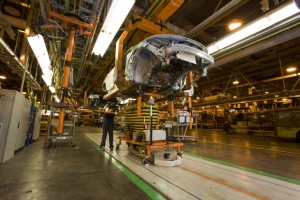
A Chevrolet Volt moves down the assembly line at the General Motors Detroit-Hamtramck Assembly Center.
For the second time this year, General Motors will halt production of the Chevrolet Volt for several weeks — but company sources insist the move does not signal problems with the plug-in hybrid which got off to a slow start after its introduction in December 2010.
In fact, GM expects to report that demand has surged to a record for the Volt this month, more than doubling year ago levels. Depending on what happens the rest of this week, August sales could near 2,500, TheDetroitBureau.com has learned.
“The sky is not falling,” insisted a well-placed GM source involved in the Volt program. In fact, Dealers across the country have less Volt inventory in stock than that of some other mainstream Chevrolet models.
Company officials declined to discuss their plans for the Chevy battery car on the record, spokesman David Darovitz stating, “We don’t comment on production schedules.” But he did note that GM “continue(s) to try to match supply and demand.”
That was the reason why the maker halted production of the Volt earlier this year for roughly a month. And it is part of the reason for the latest shutdown, which is expected to run from September 17 until October 15.
But there’s another reason, a source added, noting that the same plant that produces the Chevrolet Volt is also being retooled to begin production of the all-new 2013 Chevy Impala. That process would have required downtime at the Detroit-Hamtramck Assembly Plant no matter how strong – or weak – demand was for Volt.
The plug-in hybrid – which is rated by the EPA to get 38 miles on a charge before switching to its internal combustion engine for power – has been steadily gaining a foothold in the market, though it is still little more than an asterisk on the sales charts. For the first seven months of the year, GM sold 10,666 Volts compared to just 2,870 during the same period in 2011.
It has helped that Volt is now available nationwide, rather in a handful of early launch markets. Even more significant has been the introduction of the updated 2013 version of the plug-in. It now meets the strict P-ZEV, or “Partial-Zero-Emission Vehicle” requirements set by California regulators – which means it qualifies an owner to receive a coveted HOV sticker. That allows the Volt to be driven in the Golden State’s HOV lanes even with only one person aboard.
That’s led to a surge in demand, California now accounting for a third of Volt sales in the U.S. Dealers in the state have about a 34-day supply in an industry where 60 to 65 days of worth of a product is considered a norm. Nationwide, Chevy dealers have a 34-day inventory.
Notably, flee sales of the Volt accounted for just 3% of total volume in July – compared to an industry average 18%.
Several insiders told TheDetroitBureau.com they expect demand for Volt to continue growing in the months ahead. One specifically cited the payoff from recent surveys that have delivered a number of kudos to the hybrid – including the Total Quality Index, or TQI, announced by automotive consulting firm Strategic Vision on Monday. The Chevy Volt outperformed such stalwart rivals as the Toyota Camry and Honda Accord to rank as the highest-rated midsize passenger car on the market.
GM reports that Volt and its sibling plug-in, the Opel Ampera, have also been gaining traction in Europe and other overseas markets.
Nonetheless, it is all but certain that GM will fall short of its initial goal of producing 60,000 of the battery cars this year.
But it isn’t the only maker struggling. Nissan has seen a significant slowdown in demand for the fully electric Leaf in 2012. And most other electric vehicles have been sales challenged, as well, though Toyota claims to be meeting initial – albeit initially modest – expectations for its new Prius plug-in. The maker, meanwhile, only expects to sell about 2,600 of its pure battery-electric RAV4-EV over the next three years. Honda expects similarly minimal volume for its new Fit EV.

Hope GM keeps running those good ads for the Volt they came out with.